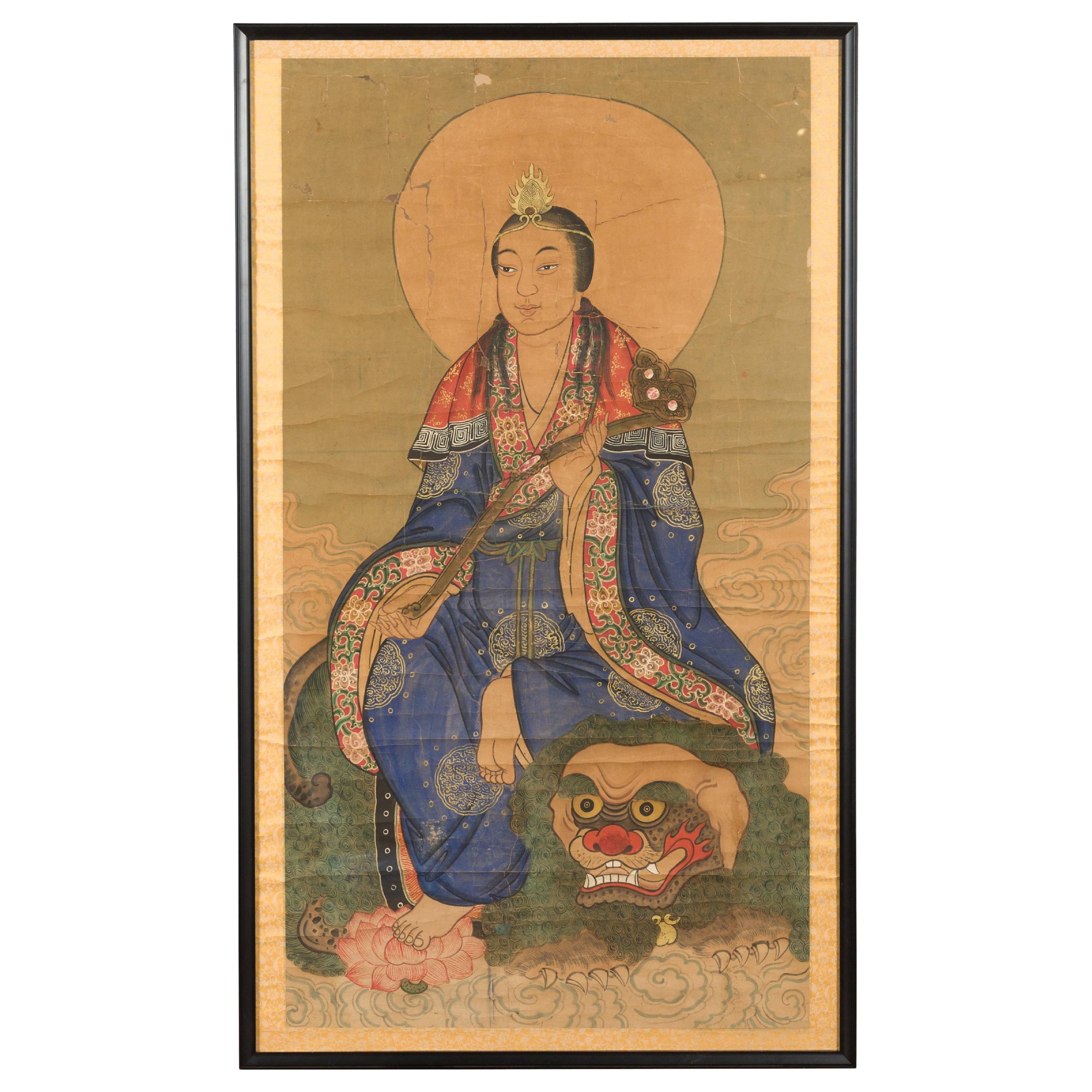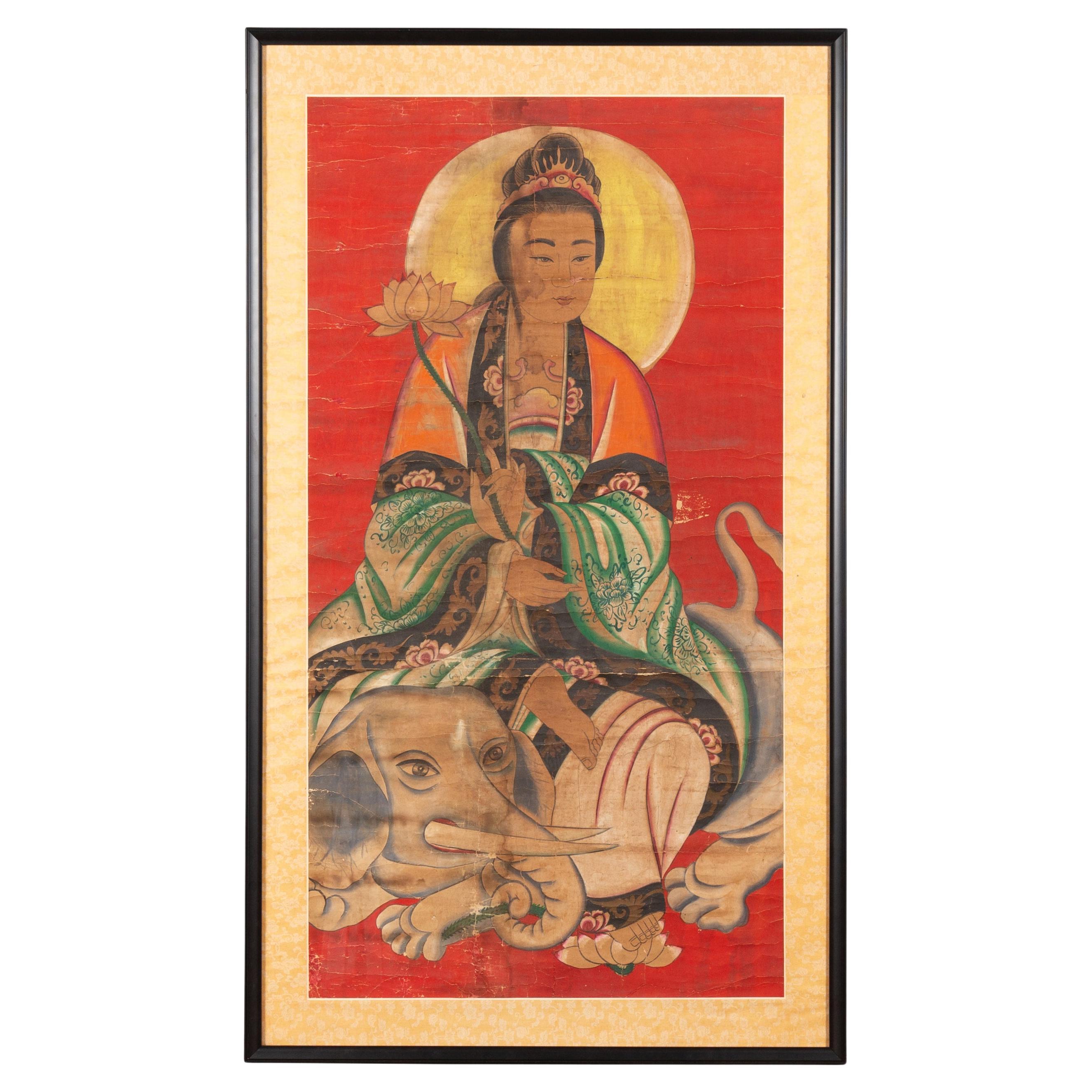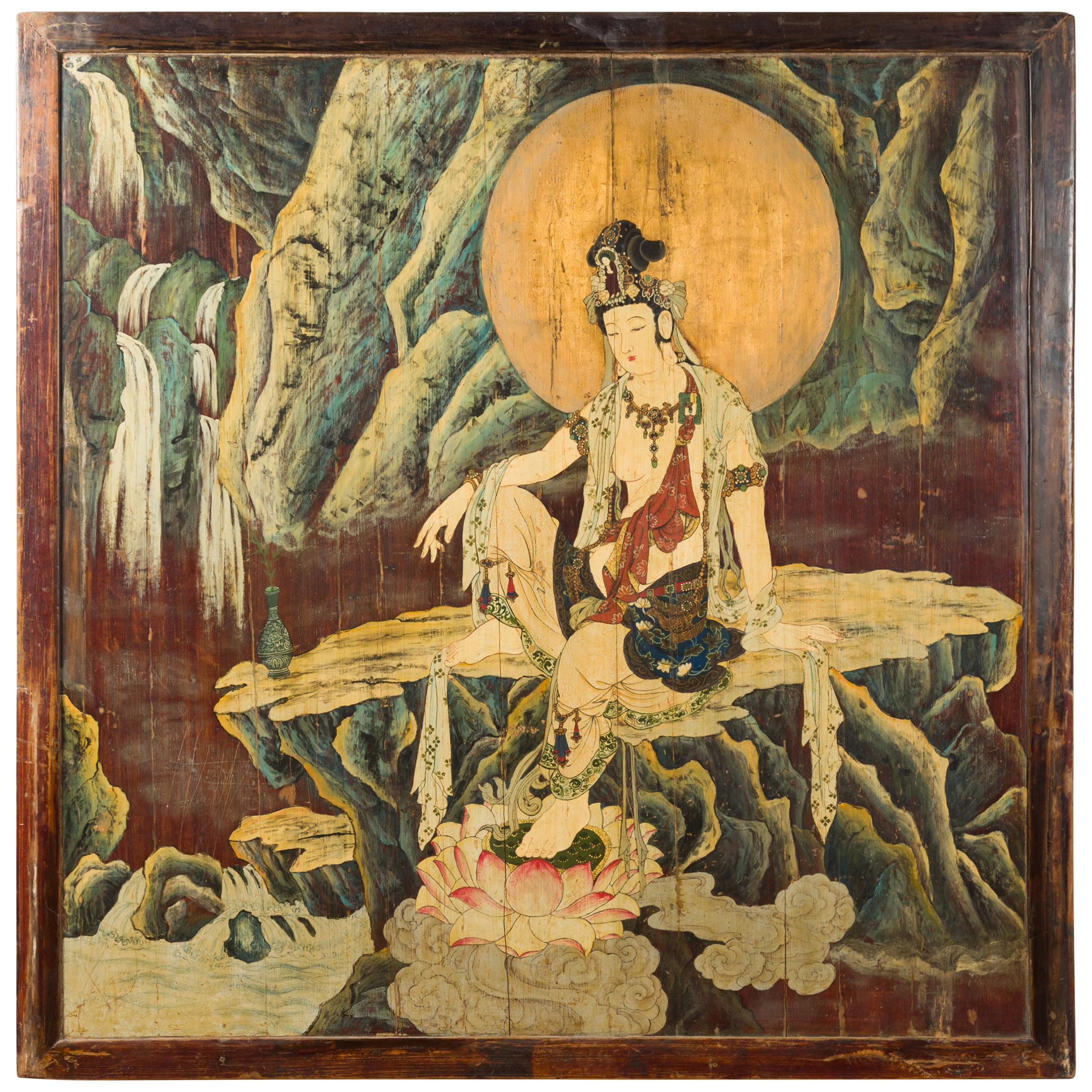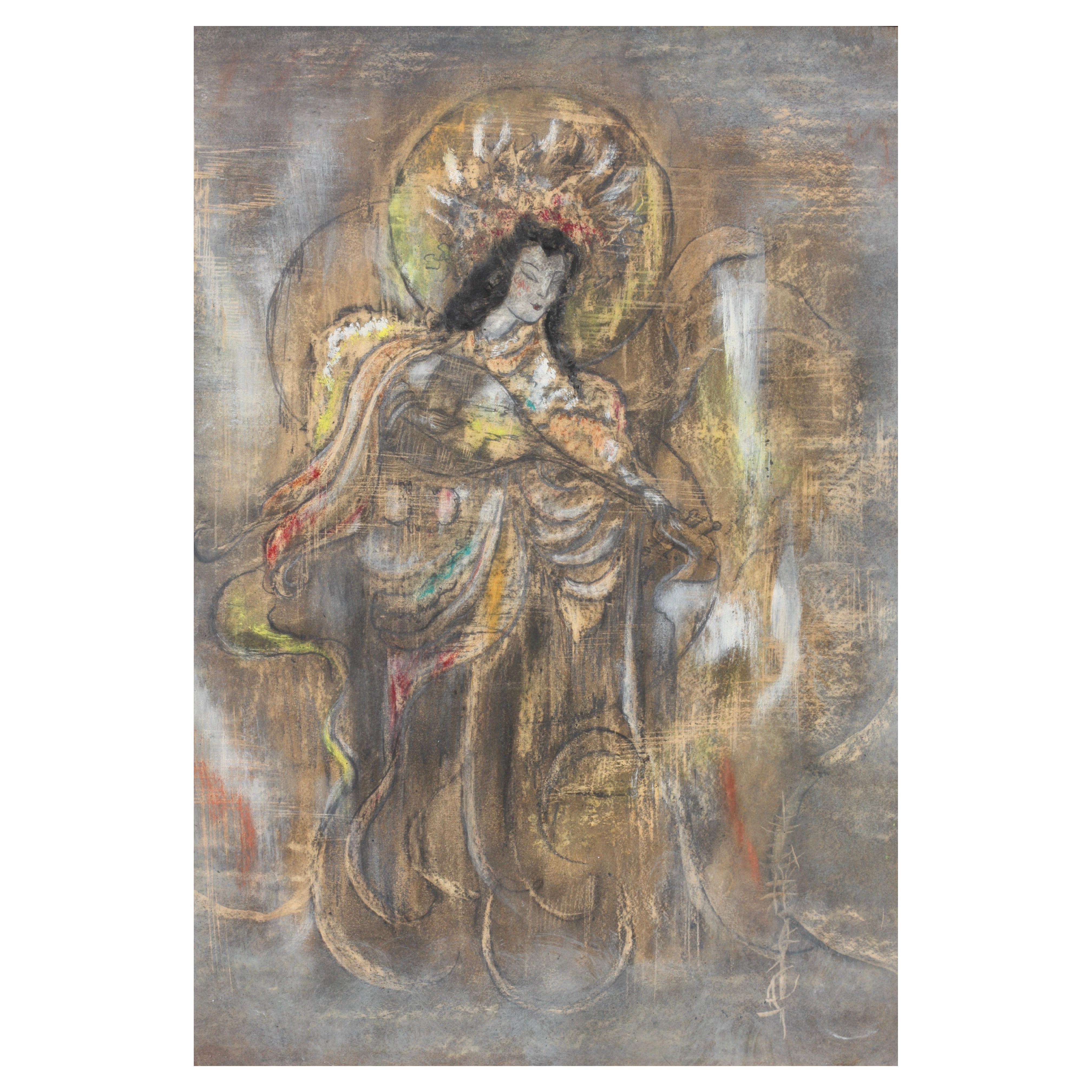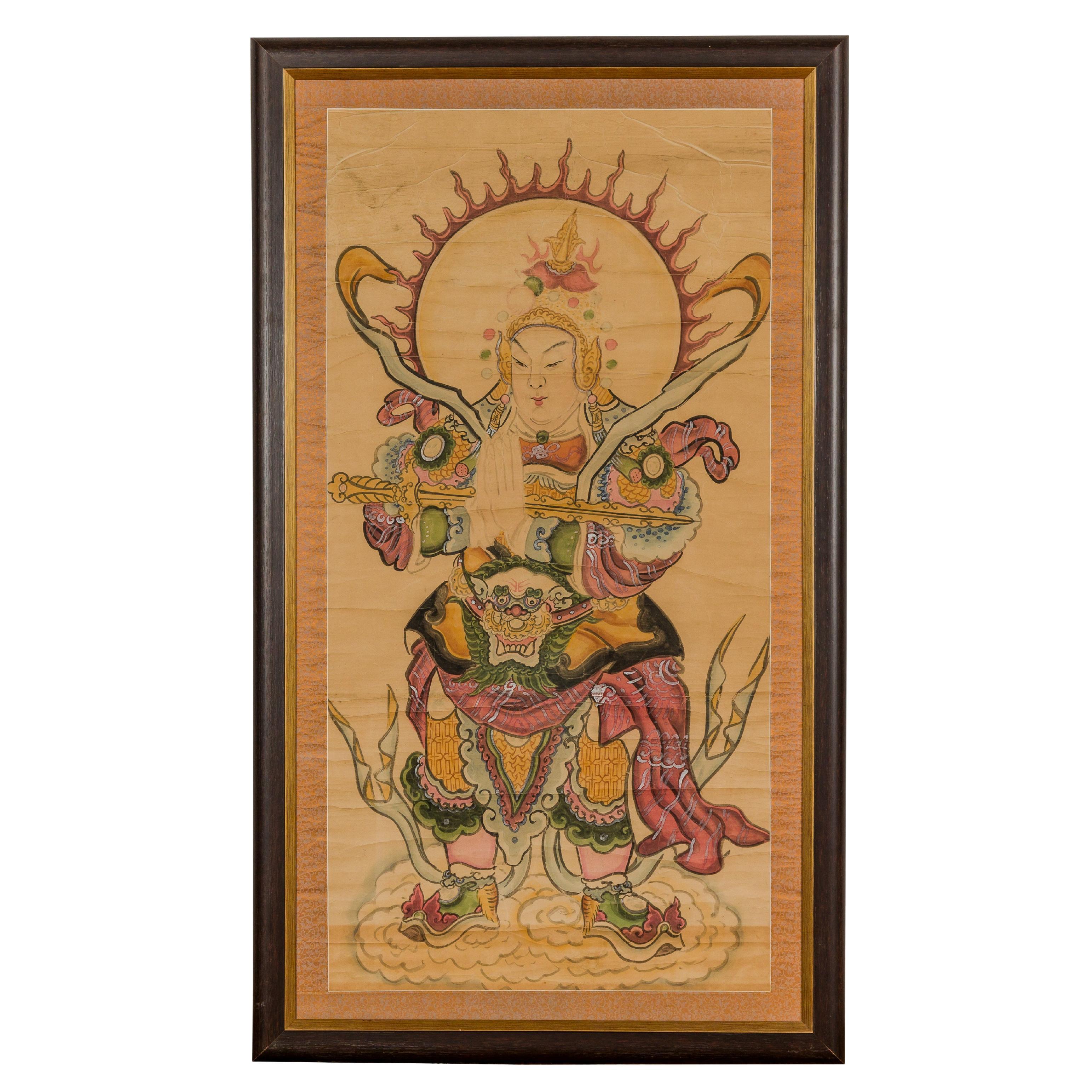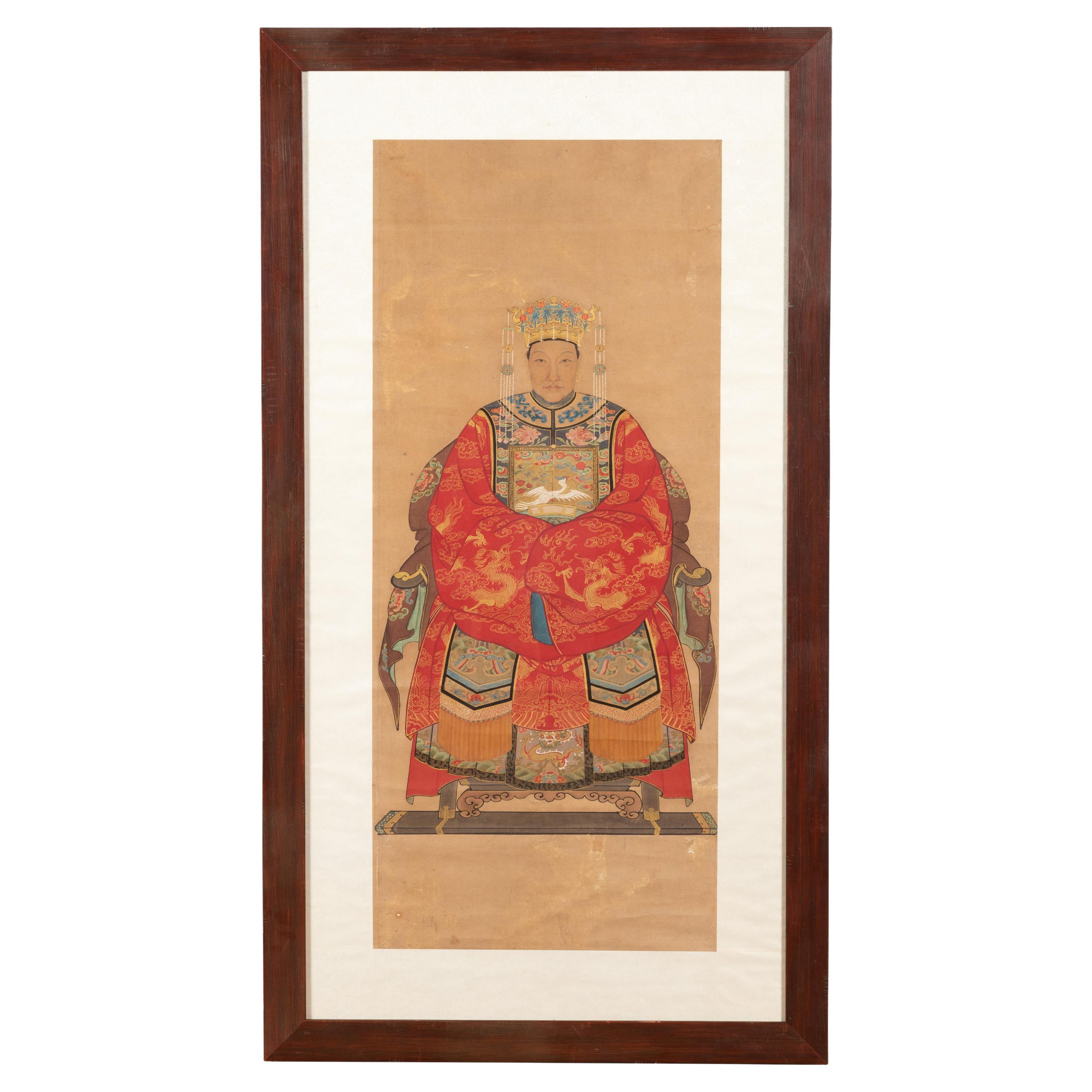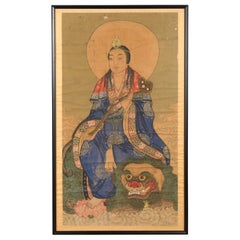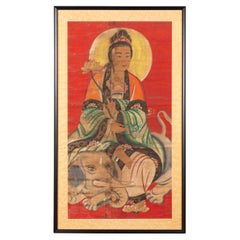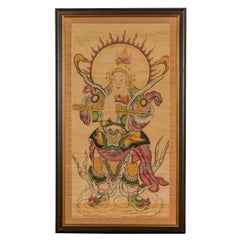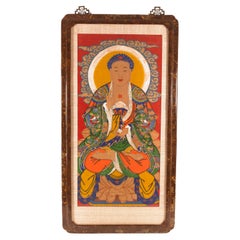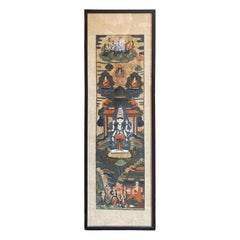Items Similar to Large Framed Indian 19th Century Painting of Guanyin Sitting on a Dragon
Want more images or videos?
Request additional images or videos from the seller
1 of 19
Large Framed Indian 19th Century Painting of Guanyin Sitting on a Dragon
$4,000
£3,023.50
€3,474.54
CA$5,569.98
A$6,196.37
CHF 3,248.21
MX$75,718.12
NOK 41,361.96
SEK 38,936.56
DKK 25,936.15
Shipping
Retrieving quote...The 1stDibs Promise:
Authenticity Guarantee,
Money-Back Guarantee,
24-Hour Cancellation
About the Item
An antique Indian painting from the 19th century depicting Guanyin the Bodhisattva of Compassion sitting on a dragon. Created in India during the 19th century, this large painting features Guanyin the Bodhisattva of Compassion, sitting on the head of a dragon. Her right foot on a lotus flower, Guanyin wears an ornate headdress and elegant clothes. The painting itself measures 27.5"W x 53.5" H and has been set inside a custom frame. With its vivid colors and elegant subject, this 19th century Indian painting in custom frame will enliven any wall beautifully, perhaps hung above a credenza, console table or enfilade.
- Dimensions:Height: 66.25 in (168.28 cm)Width: 35.25 in (89.54 cm)Depth: 2 in (5.08 cm)
- Materials and Techniques:
- Place of Origin:
- Period:
- Date of Manufacture:19th Century
- Condition:Additions or alterations made to the original: Custom frame. Wear consistent with age and use. Please refer to the various additional photos for further condition detail and contact us with any questions!
- Seller Location:Yonkers, NY
- Reference Number:Seller: YN7457 / FEA Home1stDibs: LU863926806672
About the Seller
5.0
Platinum Seller
Premium sellers with a 4.7+ rating and 24-hour response times
Established in 1968
1stDibs seller since 2009
1,162 sales on 1stDibs
Typical response time: <1 hour
- ShippingRetrieving quote...Shipping from: Yonkers, NY
- Return Policy
Authenticity Guarantee
In the unlikely event there’s an issue with an item’s authenticity, contact us within 1 year for a full refund. DetailsMoney-Back Guarantee
If your item is not as described, is damaged in transit, or does not arrive, contact us within 7 days for a full refund. Details24-Hour Cancellation
You have a 24-hour grace period in which to reconsider your purchase, with no questions asked.Vetted Professional Sellers
Our world-class sellers must adhere to strict standards for service and quality, maintaining the integrity of our listings.Price-Match Guarantee
If you find that a seller listed the same item for a lower price elsewhere, we’ll match it.Trusted Global Delivery
Our best-in-class carrier network provides specialized shipping options worldwide, including custom delivery.More From This Seller
View AllLarge Framed Indian 19th Century Painting of Guanyin Sitting on a Dragon
Located in Yonkers, NY
An antique Indian painting from the 19th century depicting Guanyin the Bodhisattva of Compassion sitting on a dragon. Created in India during the 19th century, this large painting features Guanyin the Bodhisattva of Compassion, sitting on the head of a dragon, fluffy clouds adorning the painting's lower section. Her right foot on a lotus flower, Guanyin wears an ornate headdress and elegant clothes. The painting itself measures 30.5"W x 53.5" H and has been set inside a custom frame. Its peaceful subject will make this 19th century Indian painting...
Category
Antique 19th Century Indian Paintings
Materials
Fabric, Plexiglass, Paper
19th Century Indian Print with Guanyin the Bodhisattva of Compassion on Elephant
Located in Yonkers, NY
An antique Indian print from the 19th century depicting Guanyin the Bodhisattva of Compassion. Created in India during the 19th century, this larg...
Category
Antique 19th Century Indian Prints
Materials
Fabric, Plexiglass, Wood, Paper
Large Two-Sided Painted Elmwood Divider Screen Depicting Guanyin and Zhong Kui
Located in Yonkers, NY
An antique Chinese unusual large hand painted two-sided elm divider depicting Guanyin and Zhong Kui, from the first half of the 20th century. This antique Ch...
Category
Early 20th Century Chinese Paintings and Screens
Materials
Elm
Framed Hand-Painted Parchment Painting of a Celestial Warrior with Silk Matting
Located in Yonkers, NY
A Qing Dynasty period hand-painted Celestial warrior on parchment with silk matting in custom frame. This Qing Dynasty period hand-painted depiction of a Celestial warrior is rich in...
Category
Antique 19th Century Chinese Qing Paintings
Materials
Composition
Chinese Qing Dynasty 19th Century Official's Wife Painting on Linen Canvas
Located in Yonkers, NY
A Chinese Qing Dynasty period framed painting from the 19th century of an official's wife with bird-adorned buzi, painted on a linen canvas. Created in the North-Eastern province of Shanxi during the Qing dynasty, this 19th century painting showcases a frontal depiction of an official's wife recognizable thanks to the bird-themed rank badge sitting on an elegant armchair with scrolling arms and carved apron. Wearing a red robe and topped with an ornate headdress, the figure is highlighted with gold foil accents and stands out beautifully on a linen canvas. The print size is 17.5"W x 41.5"H. These paintings traditionally come from Shanxi province which was home to many of the wealthy merchant families associated with the imperial court during the Qing dynasty. Set inside a custom made frame, this 19th century Qing Dynasty official's wife painting...
Category
Antique 19th Century Chinese Paintings
Materials
Canvas, Plexiglass, Wood
Mandarin Taoist Ceremonial Chinese Scroll Portrait Painting in Custom Frame
Located in Yonkers, NY
Mandarin Taoist Chinese ceremonial scroll portrait painting in custom plexiglass frame. Exuding an air of spiritual significance and artistic mastery, this Mandarin Taoist Chinese ce...
Category
Antique 19th Century Chinese Prints
Materials
Plexiglass, Paper
You May Also Like
Painting of Guanyin Qing Dynasty 19/20th Century Color on Silk
Located in West Palm Beach, FL
A painting of Guanyin
Qing Dynasty 19/20th century
color on silk;
The deity depicted floating, attired in long robes, adorned with jewels and wearing...
Category
20th Century Paintings and Screens
Materials
Silk
Framed Shakyamuni Buddha Thangka Painting
Located in Miami, FL
Offered is a vibrant and intricate Tibetan Buddhist "thangka" (also known as "tangka", "thanka", or "tanka"), which is what a painting that serves as a visual representation of spiri...
Category
Vintage 1960s Tibetan Tibetan Paintings and Screens
Materials
Bronze, Gold Leaf
Oriental Woman, Enamel on Board, Early 20th Century
Located in Roma, IT
Oriental woman is an original modern artwork realized in the early 20th Century by an Oriental artist.
Mixed colored enamel on board.
The painting...
Category
Early 20th Century Chinese Paintings and Screens
Materials
Enamel
$544 Sale Price
30% Off
Tibetan Buddhist Framed Thangka Painting of Buddhistic Bodhisattva Goddess Deity
Located in Studio City, CA
A beautiful, vibrantly colored, intricately designed elongated Tibetan Thangka painting featuring a multi-armed female goddess or deity (likely Avalok...
Category
Early 20th Century Tibetan Tibetan Paintings and Screens
Materials
Silk, Paint
Chinese Mythical Immortal Screen Painting, c. 1850
Located in Chicago, IL
Since the 12th century, people in China have used folding screens and doors to partition and decorate their homes - the vivid scenes backing the screens added life and color to a roo...
Category
Antique Mid-19th Century Chinese Paintings
Materials
Fabric, Paint
Large Antique Chinese Deity Scroll Painting 19th C
Located in Big Flats, NY
An oversized antique Chinese scroll painting offers depiction of deity with figures, 19th century
Measures - 69" x 26.5"
Catalogue Note: ...
Category
Antique 19th Century Asian Paintings and Screens
Materials
Paper
$760 Sale Price
20% Off
